Radio in times of emergency and disaster
Advances in technology have given people more and more ways to access an increasing amount of information. However, in a country like Bangladesh -- where access to technology is expensive, flow of information is limited or literacy rates are not up to the mark -- radio continues to play an important role in information sharing.
Community Radio (CR), as a new broadcaster media offering a fourth tier of radio broadcasting in addition to commercial and public broadcasting, serves geographic communities and communities of interest. First, it is communicated orally by using local language and at a relatively low cost -- meaning that it is accessible to people who cannot access other media. Secondly, CR is frequently paired with other communication tools, such as mobile phones for call-in shows, which enhances the likelihood of the audience taking in the information being shared, and creates a platform for two-way exchanges and learning among a wide range of actors. Finally, this platform can be used to transmit messages from one community to another and to link with national broadcasters and global networks. To promote a positive social and cultural change, community radio is considered not only as a channel to transmit information and stories to the people, but also from them.
Currently Bangladesh has 16 CR Stations, and 16 new CR stations are in different stages of establishment. There are many inspiring stories about the profound impact that CRSs have already had on local communities, not to mention on issues of self-determination, cultural sovereignty and social justice.
More than a third of the country's population lives in the coastal areas. Many are in rural areas where radio is the main medium of information. Community radio has proven to be an effective tool for disaster management, as it can readily deliver information that are suited to the needs of the community, packaged in their own language. It has helped prepare the communities to tackle any impending disaster.
During an emergency, it is critical to start broadcasting as early as possible. In addition to warning the communities in advance, CRs can broadcast updates on the damage, providing gender disaggregated data when they can. Broadcast appeal for donations, addressing women and children's special needs, can help the relief efforts. Cultural practices often prevent a woman from seeking medical help from a male doctor. In such instances, proper information can fill the gap.
Following a disaster, CRs can air counselling programmes aimed towards trauma victims. Call-in programmes, for instance, for victims to express themselves and learn from each others' experiences can have a healing effect, particularly for women, youth, and the elderly.
Special attention must also be paid to the safety of people behind the microphone, i.e. the people who are tasked with the responsibility to make it all happen. Likewise, establishing support centres for information sharing and logistic distribution with a special section for women and children can lead to efficient relief delivery.
The writers are members of Bangladesh NGO's Network for Radio & Communication (BNNRC)

 For all latest news, follow The Daily Star's Google News channel.
For all latest news, follow The Daily Star's Google News channel. 



Comments